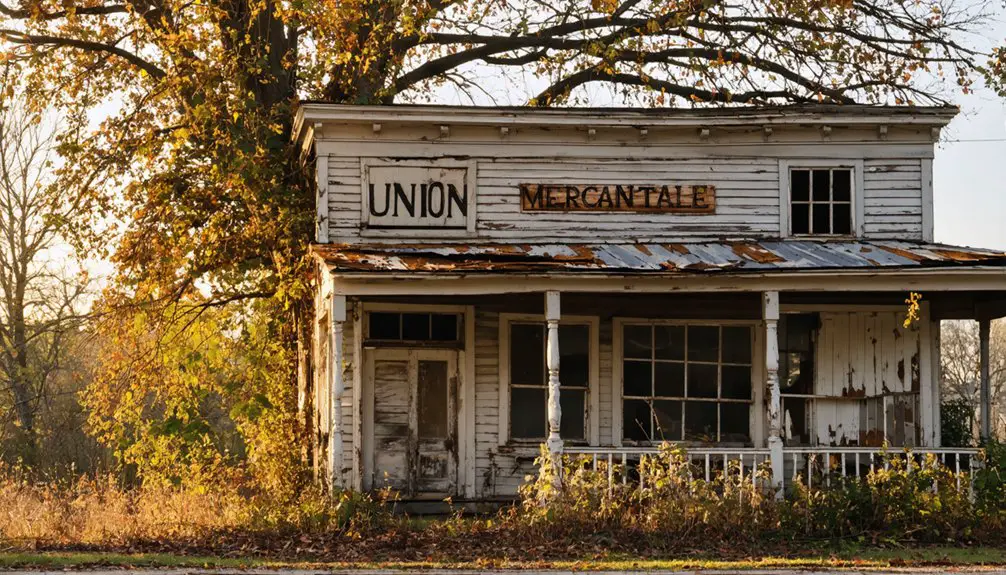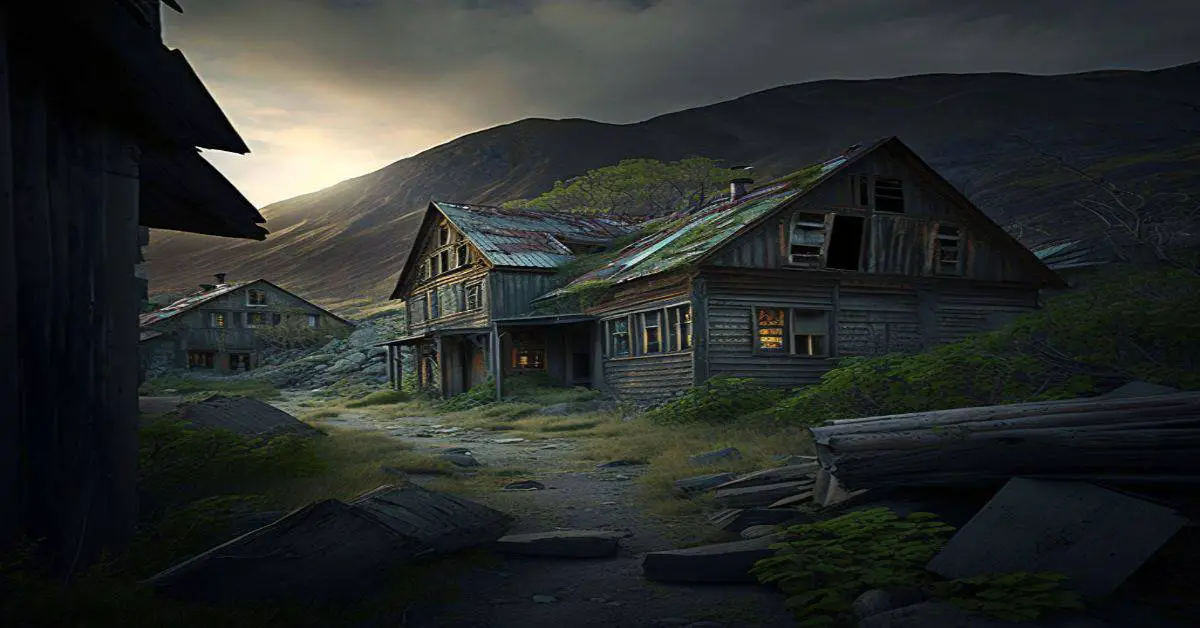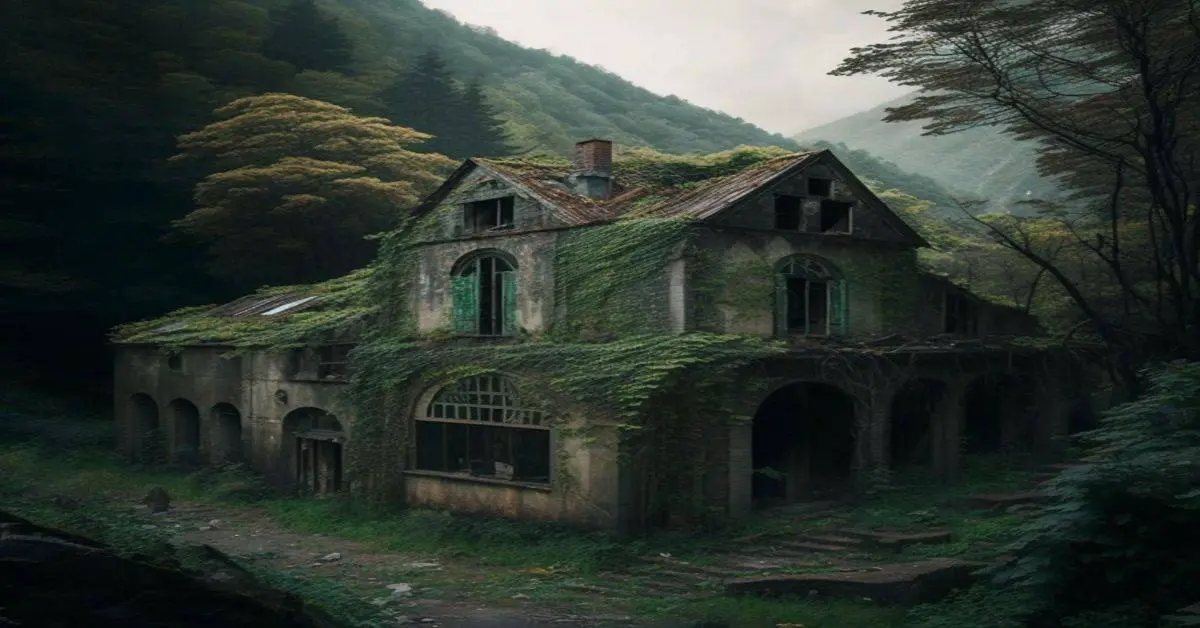You’ll find Union, Michigan’s ghost town remnants as a reminder to 19th-century frontier ambition. Founded by Bohemian immigrants and wealthy investors like Alex Joudon, this lumber settlement boasted 142 blocks, sawmills, and a $40,000 hotel during its peak. After the 1837 wildcat banking crisis and timber depletion, Union gradually declined into abandonment. Today, stone foundations, railroad tracks, and settler artifacts tell a broader story of Michigan’s resource-driven boom-and-bust cycles.
Key Takeaways
- Union was established in late 19th century Michigan as a resource-driven frontier settlement focused on lumber production and processing.
- The town’s economy relied heavily on sawmills processing 100 million board feet annually, with timber being the primary industry.
- Economic decline began after the 1837 wildcat banking crisis and eventual depletion of timber resources, leading to business closures.
- After three decades of abandonment, Union’s buildings fell into decay, with nature reclaiming the area through vegetation growth.
- Archaeological remains include the hotel’s stone foundation, railroad tracks, and settler artifacts that document the town’s frontier history.
The Birth of a Frontier Dream
As the late 19th century ushered in America’s final wave of continental expansion, Michigan’s northern frontier beckoned settlers with promises of abundant natural resources and untapped opportunities.
You’d find yourself amid a transformative era of frontier exploration, where the rich forests, navigable waterways, and mineral deposits drove passionate pioneers northward. The discovery of native copper by early settlers echoed the resourcefulness of Michigan’s first inhabitants.
Like many who ventured before you, your settler motivations might’ve included the quintessential American dream of land ownership and economic independence. This spirit of independence grew stronger as free land attracted waves of settlers seeking their fortune.
The pioneer spirit drove countless settlers westward, each carrying hopes of claiming their piece of America’s promise.
The territory’s development intertwined with fur trading posts, military outposts, and growing settlements, while steam navigation and emerging rail lines made the region increasingly accessible.
Despite tensions with Native tribes like the Ojibwa and Ottawa, who’d previously dominated these lands through treaties, you’d be part of a diverse wave of immigrants seeking to carve out your destiny in Michigan’s promising wilderness.
Early Settlement and Development Plans
While Chicago battled epidemics in the mid-1800s, waves of Bohemian immigrants and desperate families fled northward to Michigan’s untamed forests near Pyramid Bay.
These pioneers sought to establish North Unity, a fresh start away from disease-ridden cities. You’d have found immigrant experiences defined by determination as they crafted makeshift shelters from hemlock branches and weathered harsh winters in a communal wooden barracks.
- Wealthy investors like Alex Joudon purchased 600 acres, forming land companies with grand community aspirations.
- Development plans included 142 blocks subdivided into 24 lots each.
- A $40,000 hotel, sawmills, and two miles of railroad showcased ambitious infrastructure goals.
- Pre-fabricated housing sections were positioned across planned blocks, though many remained incomplete.
The Port Sheldon Land Company took charge of developing the ambitious settlement project.
The settlement’s bold vision reflected the pioneering spirit, even as challenges loomed on the horizon.
Planned amenities for the growing community included churches and schools to serve the future population.
Building the Infrastructure
Once Union’s early settlers established their foothold, they rapidly developed essential infrastructure to support the region’s booming timber industry.
You’d have seen the first sawmill rise in 1867, processing an impressive 100 million board feet of lumber annually by the 1870s. The timber transportation network initially relied on rivers to reach Lake Michigan ports, until the Grand Rapids & Indiana Railroad’s arrival in 1890 revolutionized shipping efficiency. The town was initially called Round Lake before its renaming.
You’ll notice how infrastructure development shaped Union’s layout, from the temporary wooden barracks housing immigrant workers to the construction of community buildings. Like the mining town of Central, Union established its own church and post office to serve its growing population.
The Mitchell brothers even relocated 70 of the finest homes to Cadillac, requiring substantial road improvements. Early communication systems, including telephone lines and postal services, connected the bustling town to the outside world, while churches and schools formed the backbone of community life.
Daily Life in Early Union
Life in early Union revolved around the demanding routines of frontier existence, where settlers faced harsh living conditions in crude wooden barracks and log cabins.
You’d find yourself steering daily routines that centered on survival and building a future in this developing settlement.
- You’d spend your days working in lumber mills or cutting cordwood to supply Great Lakes steamships, often alongside immigrant neighbors from Finland, Sweden, and Norway.
- Your social life would revolve around community gatherings in multipurpose buildings that served as churches, meeting halls, and entertainment venues.
- You’d collaborate with neighboring families to construct essential infrastructure and clear land for farming.
- During winter months, you’d need to be self-sufficient, as harsh conditions limited access to stores and jobs.
The local saw mill established in 1870 provided steady employment for many of the town’s earliest residents.
Like many mining boom settlements, Union experienced significant population decline once local resources were depleted.
Economic Challenges and Market Forces
Despite Union’s initial promise as a frontier settlement, the town faced devastating economic challenges that would ultimately seal its fate.
Like many Michigan towns of the era, Union struggled with economic instability triggered by the wildcat banking crisis of 1837, which dried up crucial investment capital and undermined local business growth. The town shared a similar fate to Buttersville, where the lumber mill destruction effectively ended its economic viability.
You’d have seen the town’s fortunes further decline as resource depletion took its toll. The area’s once-abundant timber resources couldn’t sustain long-term prosperity, especially when fires destroyed essential mill infrastructure. Similar to many towns across the state during the mid-1990s decline, Union’s remaining industrial operations gradually shut down.
Union’s isolation from major transportation routes made it difficult to pivot to new industries or maintain reliable market access. Agricultural endeavors provided temporary relief, but without broader economic diversification, these efforts couldn’t prevent the town’s eventual decline as market forces and changing transportation patterns left it behind.
The Town’s Gradual Decline
You’ll find Union’s transformation into a ghost town wasn’t sudden but rather the result of sustained economic pressures, as declining agricultural activity and shifting transportation routes steadily eroded its commercial viability.
The town’s businesses closed one by one while its population dwindled, leaving fewer residents to maintain the remaining structures or support local services.
The abandoned buildings, from general stores to blacksmith shops, gradually surrendered to nature’s reclamation, with untamed vegetation and weather taking their toll on the town’s physical remains.
Economic Forces Behind Failure
While Union, Michigan initially thrived as a frontier settlement, its ultimate collapse stemmed from a perfect storm of economic forces in the late 19th century. The town’s economic decline accelerated when major railway lines bypassed it, giving neighboring communities a critical advantage in trade and commerce.
- Your town’s isolation from rail transportation severely limited its ability to move goods efficiently, causing businesses to relocate to better-connected areas.
- The depletion of timber resources devastated the logging industry that had been Union’s economic backbone.
- Agricultural challenges and harsh winters made farming increasingly difficult, leading to reduced grain production and mill closures.
- Bank failures and business closures created a downward spiral, with declining tax revenue crippling the town’s ability to maintain essential services and infrastructure.
Buildings Left To Decay
Three decades of abandonment have left Union’s buildings in various states of decay, with most structures succumbing to the harsh elements of Michigan’s climate.
You’ll find former churches and schools, once vibrant community centers, reduced to weathered ruins or vanished entirely. For urban exploration enthusiasts, the remaining wooden structures tell a story through their rotting timbers, collapsed roofs, and broken windows.
The town’s architectural preservation challenges are evident in the scattered farmhouses and homes, now exposed to rain and snow.
One abandoned farmhouse, harboring remnants of a marijuana growing operation, exemplifies how nature reclaims these spaces. Tree roots and vines undermine foundations, while scavengers have stripped valuable materials like lead pipes, leaving these historic buildings to slowly dissolve into the overgrown landscape.
Abandonment and Forgotten Years
After Port Sheldon’s ambitious founding in 1835, the settlement’s grand vision crumbled rapidly during the financial crisis of 1837. The abandonment effects were swift and complete – wealthy investors fled, leaving behind their $40,000 hotel and extensive infrastructure investments.
You’d find no trace of permanent settlement or economic activity in the area for nearly a century afterward.
The forgotten memories of Port Sheldon’s existence faded as nature reclaimed the land. Here’s what happened during these dormant years:
Time slowly erased Port Sheldon from memory as vegetation consumed the abandoned settlement, leaving only whispers of its past.
- Original buildings deteriorated until only foundations remained
- Dense forest growth overtook former residential and commercial plots
- The town vanished from maps and regional awareness
- No new industries or settlements emerged during this period of neglect
The ghost town’s obscurity deepened as generations passed without development or habitation.
Archaeological Findings and Remnants
You’ll find remnants of the historic hotel’s stone foundation still marking the original town center, while nearby archaeological surveys have uncovered sections of the abandoned railroad tracks that once connected Union to larger trading posts.
Several excavations have revealed buried settler artifacts including period-specific tools, homeware fragments, and personal items dating to Union’s peak settlement years.
These physical remains provide tangible evidence of Union’s brief but significant role as a 19th-century Michigan frontier community.
Historic Hotel Foundation Remains
The historic foundation of Union’s grand hotel stands as one of the most significant archaeological remnants in this Michigan ghost town.
While the building’s historic preservation has been challenging, you can still explore its architectural significance through the remaining features that tell the story of a once-thriving communal society.
- Original blueprints called for a seven-story structure spanning a city block, though the realized building housed 90 rooms across approximately four stories.
- You’ll find unique open-air courtyards contrasting with the outer wall architecture.
- The basement remains accessible through glass-less windows, revealing 1950s-era industrial equipment.
- Evidence of adaptation appears throughout, including makeshift wood-burning stoves in abandoned boiler rooms.
The foundation operated continuously until 2001, when health violations forced its closure, marking the end of its century-long service to the community.
Railroad Track Discoveries
Deep beneath Union’s weathered soil lies an intricate network of 19th-century railroad tracks, revealing the ghost town’s bustling industrial past.
You’ll find evidence of railroad innovation throughout the site, where archaeological surveys have uncovered chain-drive steam engine parts, iron spikes, and sections of narrow-gauge rails that once connected sawmills to essential shipping docks.
The transportation legacy of these tracks tells a compelling story of industrial might.
You can trace the remains of wooden railway ties near the former dock areas, where locomotives once hauled heavy loads of hardwood lumber bound for Chicago and Milwaukee markets.
Local lore even speaks of a derailed locomotive that plunged into the water, sparking interest in underwater archaeological exploration of Union’s vanished railway empire.
Buried Settler Artifacts
Beneath layers of soil and vegetation, Union’s archaeological treasures paint a complex portrait of human habitation spanning over 14,000 years.
The marshy, forested conditions have helped preserve buried treasures that tell the story of both indigenous peoples and early settlers.
You’ll find evidence of daily life through careful artifact preservation, revealing a rich tapestry of cultural practices and technological advancement.
- Stone tools and copper artifacts demonstrate sophisticated metalworking skills of indigenous inhabitants
- Pottery shards and building foundations mark the footprint of 19th-century settler communities
- Cemetery remains provide demographic insights into the town’s former residents
- Household items and worked bone fragments offer glimpses into everyday life and cultural practices of past inhabitants
Legacy in Michigan’s History
While many Michigan ghost towns have faded into obscurity, Union’s story exemplifies the broader historical patterns that shaped the state’s development during the 19th and early 20th centuries.
You’ll find in Union’s legacy a reflection of Michigan’s resource-driven settlement patterns, where immigrant experiences and cultural heritage helped forge communities amid challenging frontier conditions.
Like other ghost towns across Michigan, Union serves as an indication of the volatile nature of resource-dependent economies.
Resource-driven economies often led Michigan’s early towns to swift rise and decline, as Union’s ghostly remains now testify.
You can trace the town’s influence in regional histories, where it stands as a cautionary tale of boom-and-bust cycles.
Today, Union’s story teaches valuable lessons about economic resilience and community adaptation, contributing to our understanding of how Michigan’s industrial ambitions and diverse immigrant populations shaped the state’s development.
Frequently Asked Questions
What Happened to the Original Inhabitants After Union Became a Ghost Town?
You’ll find the relocation impacts scattered original inhabitants across Michigan and beyond, as they sought jobs in stable communities, leaving their community legacy behind during the 1837 economic crisis.
Were There Any Documented Paranormal Activities in Abandoned Union Buildings?
You won’t find any verified ghost sightings or documented paranormal cases in Union’s abandoned buildings. Unlike Michigan’s well-known haunted locations, this ghost town lacks formal records of supernatural activity.
How Did Native American Tribes Interact With Union’s Early Settlers?
You’ll find Native Americans initially traded and partnered with settlers through cultural exchange, but relationships deteriorated after land treaties forced tribes to cede their territories to expanding American settlements.
What Role Did Women Play in Union’s Development and Economy?
You’ll find women’s contributions were essential through household management, farming support, cottage industries, and community building. Their economic impact included food production, textile making, and maintaining social support networks.
Did Any Famous Historical Figures Visit Union During Its Brief Existence?
You won’t find records of famous visitors in Union’s history. The town’s limited historical significance and remote location meant prominent figures didn’t frequent this small resource-extraction settlement during its existence.
References
- https://99wfmk.com/one-of-michigans-first-ghost-towns/
- https://wbckfm.com/one-of-michigans-first-ghost-towns/
- https://www.nps.gov/slbe/learn/historyculture/ghosttowns.htm
- https://99wfmk.com/sherman-city-michigan/
- https://lostinthestates.com/union-level-ghost-town/
- https://www.historians.org/resource/the-significance-of-the-frontier-in-american-history/
- https://en.wikipedia.org/wiki/History_of_Michigan
- https://www.d.umn.edu/cla/faculty/tbacig/cst1030/1030anth/turnerth.html
- https://spot.colorado.edu/~mcguire/turner.html
- https://www.legislature.mi.gov/documents/publications/manual/2001-2002/2001-mm-0003-0026-History.pdf


